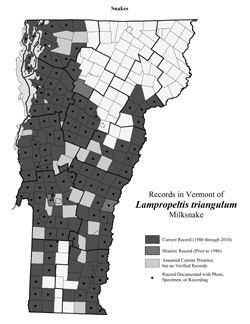Lampropeltis triangulum
Milksnake
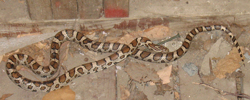
Photo by M. Dickerson.
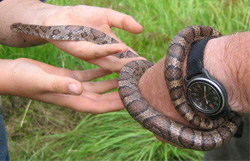
Photo by K.M. Andrews.
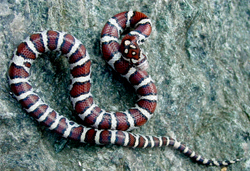
Typical juvenile (note bright colors). Photo taken by D. Berkness.
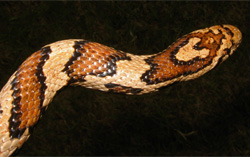
Photo taken by K. Briggs.
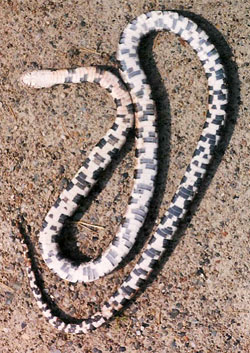
Photo taken by Maureen Rice.
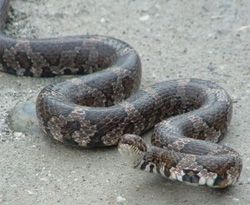
Photo by W. LaRoche.
More images from google
Identification
The Milksnake has reddish-brown blotches outlined in black. They become darker with age. They also have a white "Y" (which may be complete or broken) on the back of their head. The Milksnake's underside has a white and black checkerboard pattern. Milksnakes can grow to 2-3 feet long (the longest documented in Vermont is 43 inches) and have smooth scales.
Range/Habitat
Milksnakes inhabit old fields, old buildings, stone walls, and ledges. It is widespread at lower elevations in Vermont.
Status
This species has a state natural heritage rank of S5 (common). Please report sightings of this species in Vermont if you have not reported them within the last five years from a given location. Any natural history observations (feeding, migrations, road crossing areas, early or late season appearance, abnormalities, etc.) are appreciated. Photographs are always helpful, particularly if your report is the first report of this species from a town.
Note
The Milksnake is also known locally as the Spotted or Checkered Adder, but it is not actually an adder.
More Info
- Lampropeltis triangulum at the Animal Diversity website
- Lampropeltis triangulum at the CARCNET website
- Lampropeltis triangulum at the Snakes of Massachusetts website
Species summary written by Kaile Burgess.
In the Media
Page, Candace. 2009. Sightings of Milksnakes, Rattlesnake Mimics, Shake Residents. Burlington Free Press (July 9, 2009), 1B-2B. (Online title: Harmless snake scares homeowners). Available as PDFs: Printed from Free Press site, text-only PDF and scanned from hardcopy, PDF with pictures. (PDF reprints of copyrighted material used with permission from author.)
